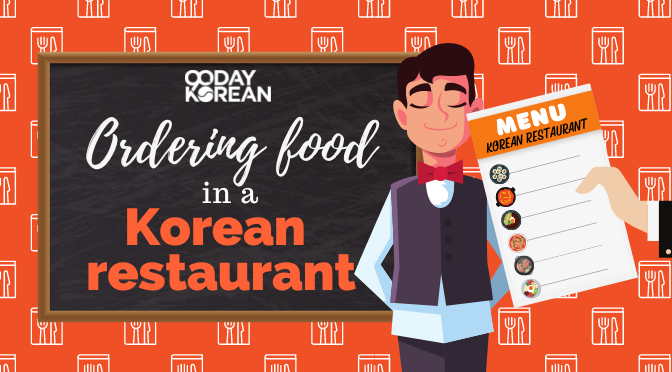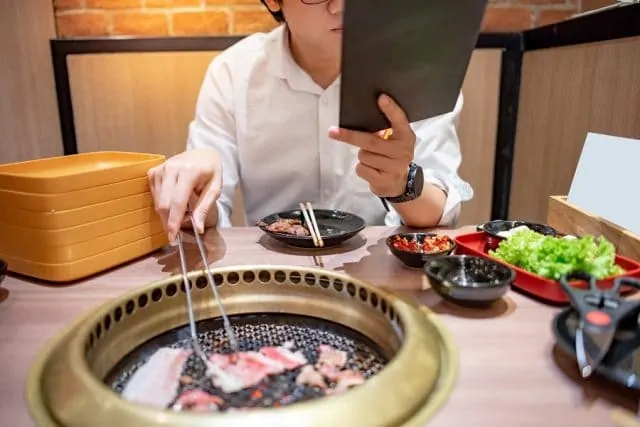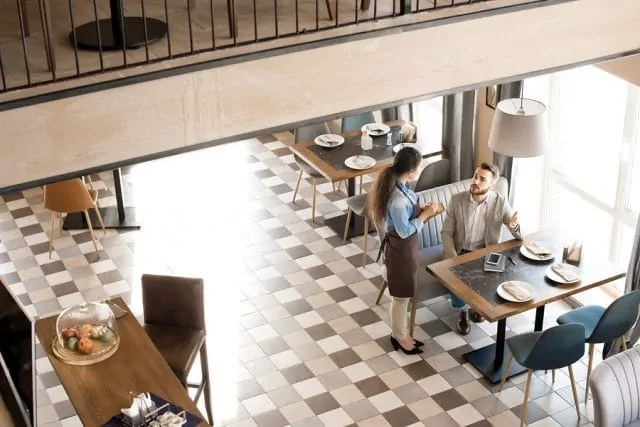If you’re in South Korea for a trip or a new life, then ordering food in a Korean restaurant might be part of your to-do list!
On top of all the dozens and dozens of sights to see and culture to experience that you have on your list, the list of traditional Korean dishes to try is an even longer one. Your stomach will growl with hunger and desire every time you think about all the delicious Korean food that will soon feed it.
But wait! Now you find yourself getting a little nervous.
It’s your first time in the country, you hardly speak the language, and it has just crossed your mind you’re not sure of the local restaurant etiquette, either. How exactly does one order food in a Korean restaurant? And more importantly: how exactly does one do the food ordering in Korean?! Keep reading, and right here, right now, you will learn exactly how!
Contents
- 1 “Restaurant” in Korean
- 2 Invaluable phrases for ordering in a Restaurant in Korea
- 2.1 “Please give me the menu” in Korean
- 2.2 Calling the waiter in Korean
- 2.3 “I will order now” in Korean
- 2.4 “May I take your order?” in Korean
- 2.5 “This, please” in Korean
- 2.6 “What is this?” in Korean
- 2.7 “What is in this?” in Korean
- 2.8 “Please give me some more of this!” in Korean
- 2.9 “Please bring me some water” in Korean
- 3 More Korean Restaurant Phrases
- 4 Asking for food recommendations in Korean
- 5 Sample Orders in Korean
- 6 Invaluable phrases to indicate dietary requirements
- 7 Paying in a restaurant in Korea
- 8 Wrap Up
“Restaurant” in Korean
The word for “restaurant” in Korean can be expressed in two ways: 식당 (sikdang) or 레스토랑 (reseutorang).
We have a separate article for more helpful words and phrases related to how to say “restaurant” in Korean.
Invaluable phrases for ordering in a Restaurant in Korea
Here are some important phrases that you can use to order popular Korean dishes and Korean liquor in a restaurant in Korea. Try them out in your favorite restaurant today.
There are two ways to ask for the menu in Korean: 메뉴 좀 주세요 (menyu jom juseyo) and 메뉴판 좀 주세요 (menyupan jom juseyo)
The first asks for the menu, and the second asks for the menu board, which you’ll encounter much more often. The only difference is that 메뉴판 (menyupan) refers to the physical menu.
Usually, the menu is visible on the restaurant wall, or it’s waiting for you at the table already. On other occasions, the staff will bring you the menu as they begin setting the table.
However, if the menu isn’t there for some reason, or you want to order more, you’ll have to ask for the menu.
Calling the waiter in Korean
When you are ready to order, and there is no service button at the table, you may shout for the waiter’s attention with either 저기요 (jeogiyo) / 여기요 (yeogiyo), which means “Hey, over there!/Hey, over here!”
Don’t worry; it’s very common and not impolite. Korean restaurants can be quite loud, so you’ll need to say it loudly.
Sometimes, Korean women use the word unnie (언니) to call female staff in restaurants. Check out the video below to learn more about this:
You can subscribe to our YouTube Channel for other helpful videos!
“I will order now” in Korean
You can add 주문하시겠어요 (jumunhashigesseoyo) after calling the waiter to express what you want to do.
“May I take your order?” in Korean
주문하시겠어요? (jumunhashigesseoyo?) is something your waiter would say to you. It’s not a phrase you would say, but you might want to be familiar with it if you hear it.
“This, please” in Korean
When ordering in Korean, you can point at the name or the picture of the menu item you wish to order and say 이거 주세요 (igeo juseyo), which means “This, please.”
The 이거 (igeo) part can also easily be replaced with the name of the dish.
“What is this?” in Korean
If you don’t know what a specific menu item is, you can ask 이게 뭐예요? (ige mwoyeyo?), which means, “What is this?”
“What is in this?” in Korean
여기 뭐가 들어가 있어요? (yeogi mwoga deureoga isseoyo?) can be used to ask about the contents of an order. This is especially good for bars and cafes since the names of the drinks don’t always tell you about the contents.
“Please give me some more of this!” in Korean
You can say 이거 좀 더 주세요! (igeo jom deo juseyo!) if you want to request a refill of the side plates. Most restaurants offer a range of side dishes to indulge in with your main meal, and it is entirely possible and free for you to request a refill of the side plates.
“Please bring me some water” in Korean
If you’re thirsty, you can say 물 좀 주세요 (mul jom juseyo), which means, “Please bring me some water.”
Much like the menu, you’re usually brought a water bottle as you sit at the restaurant.
However, if you run out of water, you’ll specifically have to request more.
Alternatively, at some restaurants, such as fried chicken restaurants, it is expected that the patrons order beer or soft drinks off the menu. So you may have to ask for the water separately.
Don’t worry, though – you’ll never get charged for water at restaurants, no matter how much you drink! ^^
More Korean Restaurant Phrases
To add to the list above, Sienna will teach you more Korean phrases that you can use in a Korean restaurant. Pay close attention to how these phrases are correctly pronounced.
Asking for food recommendations in Korean
If you don’t know what to order, you can use any of the following phrases to ask for food recommendations:
오늘 추천 메뉴는 뭐예요? (oneul chucheon menyuneun mwoyeyo?)
What is today’s recommended menu?
어떤것을 추천하세요? (eoddeongeoseul chucheonhaseyo?)
What would you recommend?
여기 뭐가 맛있어요? (yeogi mwoga masisseoyo?)
What is delicious here?
Many restaurants in Korea specialize in just one type of dish, but there are also many restaurants all around South Korea serving local and foreign dishes. With so many items on the menu, you’ll find your head spinning.
At times like these, don’t hesitate to ask the waiters what they think the best item on the menu is! They work at the place, after all, so they probably know what’s good there. Or at least what the most popular thing is.
Sample Orders in Korean
Here are some examples of phrases that you can use to order in a Korean restaurant:
삼겹살 일인분 주세요 (samgyeopsal irinbun juseyo)
Please give me one serving of samgyeopsal.
닭갈비 이인분 주세요 (dakgalbi iinbun juseyo)
Please give me two servings of dakgalbi.
When ordering Korean food, you may wish to order them in servings rather than as separate dishes.
These foods are typically shared amongst two or more people in one big dish at the center of the table, such as Korean BBQ or dakgalbi. 인분 (inbun) is the word for serving, and in front of the word, add the number of servings you are ordering.
Invaluable phrases to indicate dietary requirements
If there is some food that you can’t or don’t eat, you can let them know of your preferences. This way, the restaurant staff can provide you with other suggestions.
“I’m a vegetarian” in Korean
If you can’t eat meat, or only consume fruits and vegetables, you can say 전 채식주의자에요 (jeon chaeshikjuijaeyo), which means “I’m a vegetarian.”
A majority of Koreans are meat-eaters, and vegetarians aren’t often readily catered to. So it’s important to check with the restaurant staff before sitting down whether there are items on the menu that you can eat.
“Do you have a vegetarian menu” in Korean
If you want to ask for the vegetarian menu, you can say 채식메뉴 있으세요? (chaeshikmenyu isseuseyo?)
“I can’t eat pork” in Korean
If you can’t eat pork, you can say 저는 돼지고기를 못 먹어요 (jeon dwaejigogireul mot meokeoyo), which means “I can’t eat pork.”
Pork also happens to be the staple meat for the daily diet of Koreans, so you will want to check with the waiters about pork-free dishes to eat.
“Do you have any dishes without pork” in Korean
You can say 돼지고기 없는 메뉴 있으세요? (dwaejigogi eobneun menyu isseuseyo?) to ask for pork-free dishes. Don’t worry, there are usually other things, at least beef and chicken anyway.
Paying in a restaurant in Korea
When in restaurants in Korea, you do not ask for the bill separately. Instead, you go directly to the counter and pay after finishing your meal on your way out.
Additionally, in Korea, especially at pubs, it is customary for one person to pay the entire bill. So if you’re not the one paying for the food, you may wish to return the favor by paying for the dessert at a nearby cafe.
How to say “I’ll pay” in Korean
This phrase is what you’ll say if you want to treat the other person or people in your group to a meal or even a round of beers.
제가 낼게요. (jega naelgeyo.)
I’ll pay.
내가 낼게. (naega naelge.)
I’ll pay.
Splitting the bill in Korean
Don’t worry, though; splitting the bill is very common these days, so the staff can split the bill for you without issue.
Many places can even split bills on multiple credit cards.
When you’re traveling and out drinking traditional Korean liquors with your non-Korean friends or fellow travelers, you will still want to pay separately or “split the bill.” In this case, here is what you can say to the cashier:
반반해 주세요. (banbanhae juseyo.)
Please halve the bill.
계산서를 따로따로 할게요. (gyesanseoreul ddaroddaro halgeyo.)
We’ll pay separately.
계산서 나누어 줄 수 있으세요? (gyesanseo nanueo jul su isseuseyo?)
Can you split the bill?
Wrap Up
And now you are completely ready for your first adventure of ordering in Korean in a local restaurant! Use the Korean words and phrases that you just learned! Here’s another resource for food-related vocabulary that might help you more.
Now go out and enjoy all the fantastic food Korea has to offer! Need any ideas for places you could try out? Check out our list of essential restaurants to try in Korea. You’ll definitely find a good restaurant from this list! We have a bunch of other useful Korean words and Korean phrases to teach you, so keep learning!
Want to order in Korean with confidence? Our 90 Day Korean Membership program gives you a structured online course that will help you learn Korean fast. You’ll be having 3-minute conversations in the first 90 Days!
Photo credit: BigStockPhoto









How do you say? “Can I order 1 more set of the lamb skewer barbecue?”
You can say 양꼬치 바비큐 한 세트 더 주문할 수 있나요? ^^
Hi how do you ask for non spycy dishes if you have a sensitive stomach?
You can say 안 매운 요리 있어요? for “Is there any non-spicy dish?” You can also say 매운 음식 못 먹어요 for “I cannot eat spicy food.”
How would you ask to take something off a certain dish?
For example: “Could you take the beef off of the 잡채?”
You can say 잡채에서 소고기 좀 빼주실 수 있어요? for “Could you take the beef off of the 잡채?” or
잡채에서 소고기는 빼 주세요 for “please take the beef off from 잡채.”
How do you order fast food in Korean? For eg, can I have a 6piece chicken nuggets, to go
You can say 치킨 너겟 6 조각 포장해 주세요. ^^
Hi,
how do you ask for garlic soy fried chicken?
You can say ‘마늘 간장 후라이드 치킨 주세요’. ^^